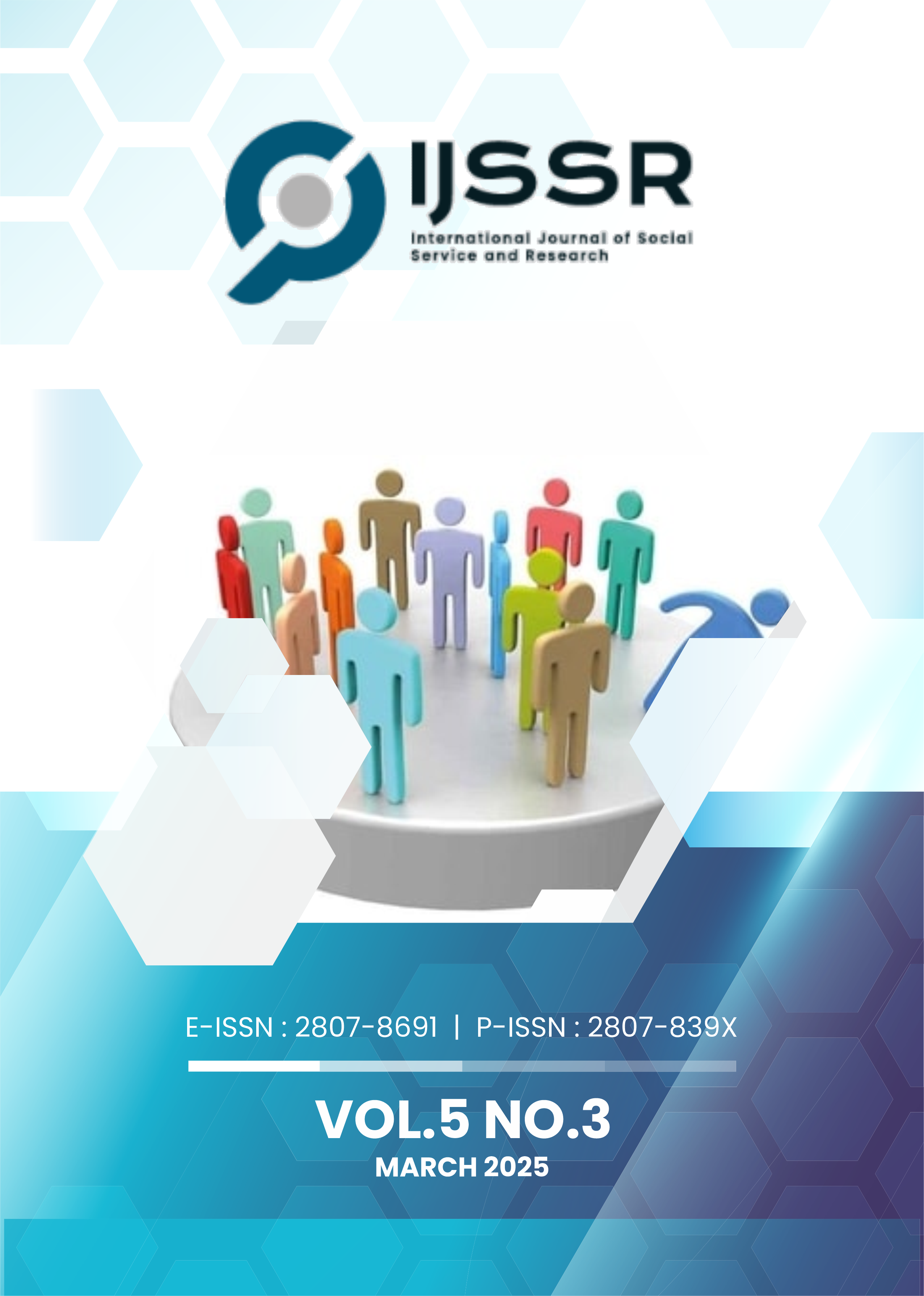ANALYSIS OF FARMERS INCOME SELLING IN SUCO LOUR ZUMALAI ADMINISTRATIVE POST-COVALIMA MUNICIPALITY
DOI:
https://doi.org/10.46799/ijssr.v5i3.1206Keywords:
benefit, farmer, incomeAbstract
The research aims to analyze farmers' income selling Corn in Suco Lour, Zumalai Administrative Post, Covalima Municipality. The research employs descriptive methods, utilizing a simple random sampling technique to select a sample of 100 farmers from the population. The data collection involves three methods: interviews, which facilitate direct communication with the farming community; observation to witness farming activities firsthand; and questionnaires designed to gather structured information. The researcher analyzed with the results of counting through economic analysis equipment, responded with significant results as follows: (i) the total number of farmer family members responded in fifty (50), discovered farmers Secondary Education with its minimum frequency of two (2) people, 4 percent, discovered non-alphabetic farmers got the highest frequency of twenty-one (21) people, with 42%. (ii) The impact of technology on productivity: Investigate how the adoption of modern agricultural technologies influences corn production efficiency and income levels among farmers. The study highlights the factors influencing earnings, including production costs, market access, and pricing strategies. This research can inform policymakers and agricultural stakeholders about the economic challenges faced by local farmers, guiding the development of targeted interventions to enhance profitability and sustainability in the agricultural sector. Furthermore, the findings may serve as a basis for further studies on income diversification and agricultural practices in similar regions, ultimately contributing to improved livelihoods for farming communities.
References
Bocean, C. G. (2024). A Cross-Sectional Analysis of the Relationship between Digital Technology Use and Agricultural Productivity in EU Countries. Agriculture, 14(4), 519. https://doi.org/10.3390/agriculture14040519
Chen, T., Rizwan, M., & Abbas, A. (2022). Exploring the Role of Agricultural Services in Production Efficiency in Chinese Agriculture: A Case of the Socialized Agricultural Service System. Land, 11(3). https://doi.org/10.3390/land11030347
Department of Agriculture of Timor-Leste. (2012). Data of corn production area in Timor-Leste. Department of Agriculture of Timor-Leste.
Duncan, E., Rotz, S., Magnan, A., & Bronson, K. (2022). Disciplining land through data: The role of agricultural technologies in farmland assetisation. Sociologia Ruralis, 62(2). https://doi.org/10.1111/soru.12369
Ginting, T. Y., Mastuti, R., Supristiwendi, S., & Bulkaini, B. (2024). INCOME ANALYSIS OF MAIZE FARMERS ON RUBBER PLANTATION HIATEN LAND UTILIZATION SUNGEI PUTIH RESEARCH UNIT. Agrisocionomics: Jurnal Sosial Ekonomi Pertanian, 8(1), 193–204. https://doi.org/10.14710/agrisocionomics.v8i1.18040
Heaberlin, B., & Shattuck, A. (2023). Farm stress and the production of rural sacrifice zones. Journal of Rural Studies, 97. https://doi.org/10.1016/j.jrurstud.2022.11.007
Jänicke, C., & Müller, D. (2025). Revealing agricultural land ownership concentration with cadastral and company network data. Agriculture and Human Values, 42(1), 159–175. https://doi.org/10.1007/s10460-024-10590-3
Kim, C., Miao, M., & Hu, B. (2022). Relations between merchandising information orientation, strategic integration and retail performance. International Journal of Retail and Distribution Management, 50(1). https://doi.org/10.1108/IJRDM-07-2020-0244
Kubitza, C., Hackfort, S., Opiyo, A., Rauh, C., Stokes, C. S., & Huyskens-Keil, S. (2024). The effects of market-oriented farming on living standards, nutrition, and informal sharing arrangements of smallholder farmers: the case of African indigenous vegetables in Kenya. Food Security, 16(6), 1363–1379. https://doi.org/10.1007/s12571-024-01480-x
Kugbega, S. K., & Aboagye, P. Y. (2021). Farmer-herder conflicts, tenure insecurity and farmer’s investment decisions in Agogo, Ghana. Agricultural and Food Economics, 9(1). https://doi.org/10.1186/s40100-021-00186-4
Lin, R. (2011). Allocating fixed costs or resources and setting targets via data envelopment analysis. Applied Mathematics and Computation, 217(13). https://doi.org/10.1016/j.amc.2011.01.008
Lovarelli, D., Fiala, M., & Larsson, G. (2018). Fuel consumption and exhaust emissions during on-field tractor activity: A possible improving strategy for the environmental load of agricultural mechanisation. Computers and Electronics in Agriculture, 151. https://doi.org/10.1016/j.compag.2018.06.018
Ma, W., Rahut, D. B., Sonobe, T., & Gong, B. (2024). Linking farmers to markets: Barriers, solutions, and policy options. Economic Analysis and Policy, 82, 1102–1112. https://doi.org/10.1016/j.eap.2024.05.005
Madsen, S. (2022). Farm-level pathways to food security: beyond missing markets and irrational peasants. Agriculture and Human Values, 39(1). https://doi.org/10.1007/s10460-021-10234-w
Mishenin, Y., Yarova, I., & Koblianska, I. (2021). Ecologically Harmonized Agricultural Management for Global Food Security. In Ecological Intensification of Natural Resources for Sustainable Agriculture. Springer. https://doi.org/10.1007/978-981-33-4203-3_2
Mukoviz, V., Leshchii, L., Khodakivska, O., Prokopova, O., & Kuzub, M. (2022). ACCOUNTING FOR TRANSACTIONS COSTS OF AGRICULTURAL PRODUCERS IN THE SHADOW ECONOMY. Agricultural and Resource Economics, 8(2). https://doi.org/10.51599/are.2022.08.02.04
Sodoma, R., Shmatkovska, T., Dziamulych, M., Vavdiiuk, N., Kutsai, N., & Polishchuk, V. (2022). ECONOMIC EFFICIENCY OF THE LAND RESOURCE MANAGEMENT AND AGRICULTURAL LAND-USE BY AGRICULTURAL PRODUCERS. Management Theory and Studies for Rural Business and Infrastructure Development, 43(4). https://doi.org/10.15544/mts.2021.47
Sukayat, Y., Setiawan, I., Suharfaputra, U., & Kurnia, G. (2023). Determining Factors for Farmers to Engage in Sustainable Agricultural Practices: A Case from Indonesia. Sustainability (Switzerland), 15(13). https://doi.org/10.3390/su151310548
Ume, C. (2023). The role of improved market access for small-scale organic farming transition: Implications for food security. Journal of Cleaner Production, 387. https://doi.org/10.1016/j.jclepro.2023.135889
Zhang, J., Mishra, A. K., & Hirsch, S. (2021). Market-oriented agriculture and farm performance: Evidence from rural China. Food Policy, 100. https://doi.org/10.1016/j.foodpol.2021.102023
Zhang, J., Yong, H., & Lv, N. (2023). Balancing Productivity and Sustainability: Insights into Cultivated Land Use Efficiency in Arid Region of Northwest China. Journal of the Knowledge Economy. https://doi.org/10.1007/s13132-023-01652-8
Zhang, Y., Lu, X., Zhang, M., Ren, B., Zou, Y., & Lv, T. (2022). Understanding farmers’ willingness in arable land protection cooperation by using fsQCA: Roles of perceived benefits and policy incentives. Journal for Nature Conservation, 68. https://doi.org/10.1016/j.jnc.2022.126234
Downloads
Published
Issue
Section
License
Copyright (c) 2025 Heribertos A. Colo, Maria Tilman, Aleixo Martins

This work is licensed under a Creative Commons Attribution-ShareAlike 4.0 International License.
Authors who publish with this journal agree to the following terms:
- Authors retain copyright and grant the journal right of first publication with the work simultaneously licensed under a Creative Commons Attribution-ShareAlike 4.0 International. that allows others to share the work with an acknowledgement of the work's authorship and initial publication in this journal.
- Authors are able to enter into separate, additional contractual arrangements for the non-exclusive distribution of the journal's published version of the work (e.g., post it to an institutional repository or publish it in a book), with an acknowledgement of its initial publication in this journal.
- Authors are permitted and encouraged to post their work online (e.g., in institutional repositories or on their website) prior to and during the submission process, as it can lead to productive exchanges, as well as earlier and greater citation of published work.













